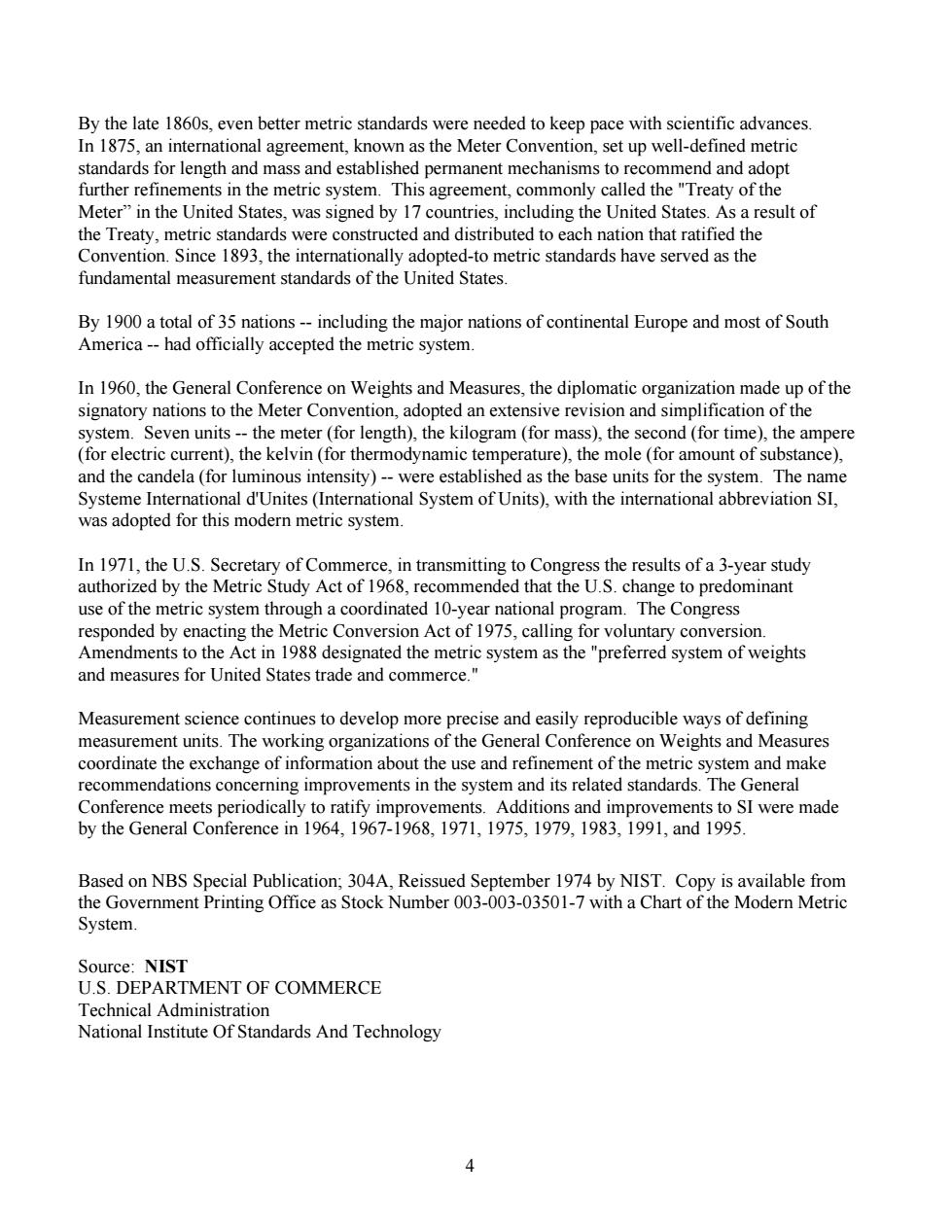正在加载图片...

By the late 1860s,even better metric standards were needed to keep pace with scientific advances In 1875,an international agreement,known as the Meter Convention,set up well-defined metric standards for length and mass and established permanent mechanisms to recommend and adopt further refinements in the metric system.This agreement,commonly called the "Treaty of the Meter"in the United States,was signed by 17 countries,including the United States.As a result of the Treaty,metric standards were constructed and distributed to each nation that ratified the Convention.Since 1893,the internationally adopted-to metric standards have served as the fundamental measurement standards of the United States. By 1900 a total of 35 nations--including the major nations of continental Europe and most of South America--had officially accepted the metric system. In 1960,the General Conference on Weights and Measures,the diplomatic organization made up of the signatory nations to the Meter Convention,adopted an extensive revision and simplification of the system.Seven units--the meter(for length),the kilogram(for mass),the second(for time),the ampere (for electric current),the kelvin (for thermodynamic temperature),the mole (for amount of substance), and the candela(for luminous intensity)--were established as the base units for the system.The name Systeme International d'Unites(International System of Units),with the international abbreviation SI. was adopted for this modern metric system. In 1971,the U.S.Secretary of Commerce,in transmitting to Congress the results of a 3-year study authorized by the Metric Study Act of 1968,recommended that the U.S.change to predominant use of the metric system through a coordinated 10-year national program.The Congress responded by enacting the Metric Conversion Act of 1975,calling for voluntary conversion. Amendments to the Act in 1988 designated the metric system as the "preferred system of weights and measures for United States trade and commerce." Measurement science continues to develop more precise and easily reproducible ways of defining measurement units.The working organizations of the General Conference on Weights and Measures coordinate the exchange of information about the use and refinement of the metric system and make recommendations concerning improvements in the system and its related standards.The General Conference meets periodically to ratify improvements.Additions and improvements to SI were made by the General Conference in1964,1967-1968,1971,1975,1979,1983,1991,and1995 Based on NBS Special Publication;304A,Reissued September 1974 by NIST.Copy is available from the Government Printing Office as Stock Number 003-003-03501-7 with a Chart of the Modern Metric System. Source:NIST U.S.DEPARTMENT OF COMMERCE Technical Administration National Institute Of Standards And Technology 4By the late 1860s, even better metric standards were needed to keep pace with scientific advances. In 1875, an international agreement, known as the Meter Convention, set up well-defined metric standards for length and mass and established permanent mechanisms to recommend and adopt further refinements in the metric system. This agreement, commonly called the "Treaty of the Meter” in the United States, was signed by 17 countries, including the United States. As a result of the Treaty, metric standards were constructed and distributed to each nation that ratified the Convention. Since 1893, the internationally adopted-to metric standards have served as the fundamental measurement standards of the United States. By 1900 a total of 35 nations -- including the major nations of continental Europe and most of South America -- had officially accepted the metric system. In 1960, the General Conference on Weights and Measures, the diplomatic organization made up of the signatory nations to the Meter Convention, adopted an extensive revision and simplification of the system. Seven units -- the meter (for length), the kilogram (for mass), the second (for time), the ampere (for electric current), the kelvin (for thermodynamic temperature), the mole (for amount of substance), and the candela (for luminous intensity) -- were established as the base units for the system. The name Systeme International d'Unites (International System of Units), with the international abbreviation SI, was adopted for this modern metric system. In 1971, the U.S. Secretary of Commerce, in transmitting to Congress the results of a 3-year study authorized by the Metric Study Act of 1968, recommended that the U.S. change to predominant use of the metric system through a coordinated 10-year national program. The Congress responded by enacting the Metric Conversion Act of 1975, calling for voluntary conversion. Amendments to the Act in 1988 designated the metric system as the "preferred system of weights and measures for United States trade and commerce." Measurement science continues to develop more precise and easily reproducible ways of defining measurement units. The working organizations of the General Conference on Weights and Measures coordinate the exchange of information about the use and refinement of the metric system and make recommendations concerning improvements in the system and its related standards. The General Conference meets periodically to ratify improvements. Additions and improvements to SI were made by the General Conference in 1964, 1967-1968, 1971, 1975, 1979, 1983, 1991, and 1995. Based on NBS Special Publication; 304A, Reissued September 1974 by NIST. Copy is available from the Government Printing Office as Stock Number 003-003-03501-7 with a Chart of the Modern Metric System. Source: NIST U.S. DEPARTMENT OF COMMERCE Technical Administration National Institute Of Standards And Technology 4